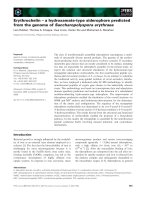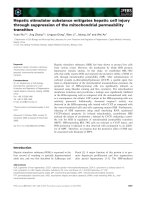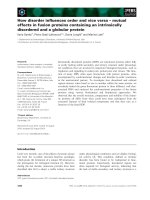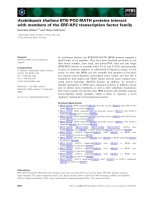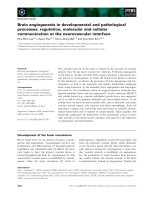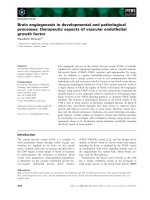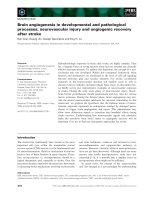Tài liệu Báo cáo khoa học: Brain angiogenesis in developmental and pathological processes: therapeutic aspects of vascular endothelial growth factor doc
Bạn đang xem bản rút gọn của tài liệu. Xem và tải ngay bản đầy đủ của tài liệu tại đây (297.14 KB, 8 trang )
MINIREVIEW
Brain angiogenesis in developmental and pathological
processes: therapeutic aspects of vascular endothelial
growth factor
Masabumi Shibuya
1,2
1 Department of Molecular Oncology, Tokyo Medical and Dental University, Japan
2 Jobu University, Takasaki, Japan
Introduction
The central nervous system (CNS) is a complex of
well-vascularized tissues through which oxygen and
nutrition are supplied to the brain via the carotid
artery. Actually, cells such as neurons and glial cells in
the CNS require a fresh supply of blood to function.
In embryogenesis, the formation of primitive blood
vessels from progenitors, hemangioblasts ⁄ angioblasts,
is dependent on the vascular endothelial growth fac-
tor ⁄ vascular endothelial growth factor receptor
(VEGF ⁄ VEGFR) system [1,2], and the further devel-
opment of blood vessels in various tissues and organs,
including the brain, is regulated by the VEGF system
in combination with other signaling systems such as
the angiopoietin–Tie, ephrin–Eph, Delta–Notch sys-
tems, and the Wnt pathway.
Furthermore, the blood vessel network in the CNS
has a unique stabilizing system at the postnatal to
adult stages known as the blood–brain barrier (BBB)
Keywords
macrophage; malignant glioma; motor
neuron; tumor angiogenesis; vascular
hyperpermeability; VEGF-A; VEGF-B;
VEGF-E; VEGFR-1; VEGFR-2
Correspondence
M. Shibuya, Department of Molecular
Oncology, Tokyo Medical and Dental
University, 1-5-45 Yushima, Bunkyo-ku,
Tokyo 113-8519, Japan
Fax: +81 3 5803 0125
Tel: +81 3 5803 5086
E-mail:
(Received 19 February 2009, revised 26
May 2009, accepted 15 June 2009)
doi:10.1111/j.1742-4658.2009.07175.x
The angiogenic process in the central nervous system (CNS) is basically
regulated by typical angiogenic signaling systems such as vascular endothe-
lial growth factor (VEGF)–VEGF receptors and angiopoietin–Tie recep-
tors. In addition to regular endothelial–pericyte interaction, the CNS
vasculature has a unique system of cell to cell communication between
endothelial cells and astrocytes which is known as the blood–brain barrier.
Among the pathological conditions of the CNS vascular network, stroke is
a major disease in which the supply of blood is decreased. Pro-angiogenic
therapy using natural VEGF-A has so far been unsuccessful, indicating the
possible need for a new approach related to upstream or downstream regu-
lators involved in the VEGF-signaling pathway, or alternate VEGF family
members. By contrast, a pathological increase in the blood supply in the
CNS is seen in brain tumors, in particular malignant gliomas. In phase II
clinical trials, anti-VEGF therapies have been shown to suppress tumor
growth and improve survival rates to some extent. However, tumor inva-
sion and the distant metastasis of gliomas can occur following anti-angio-
genic therapy. Further studies are needed to obtain safer clinical outcomes
by developing new strategies with combination therapy using known anti-
angiogenic drugs or by developing unique medicines specifically targeting
the blood vessels in brain tumors.
Abbreviations
BBB, blood–brain barrier; CNS, central nervous system; EC, endothelial cell; FGF, fibroblast growth factor; HIF, hypoxia-inducible factor;
PlGF, placenta growth factor; VEGF, vascular endothelial growth factor; VEGFR, vascular endothelial growth factor receptor; VHL, von
Hippel–Lindau.
4636 FEBS Journal 276 (2009) 4636–4643 ª 2009 The Author Journal compilation ª 2009 FEBS
[3]. The BBB mainly consists of a strong interaction
between vascular endothelial cells and astrocytes, and
the tight junctions of vascular endothelial cells (ECs)
in the BBB are well organized with claudins and ZO-
proteins through a decrease in angiogenesis signaling
and an increase in the stability of ECs by the
AKAP12 ⁄ SSeCKS ⁄ Gravin and other systems [4].
Because the VEGF–VEGFR system is central to
angiogenesis in almost all stages of life, we briefly
introduce it here (Fig. 1), followed by discussion of
two pathological conditions of angiogenesis in the
brain, stroke and brain tumors, along with possible
therapeutic strategies.
VEGF and VEGFRs
The VEGF family
The VEGF family includes VEGF-A (also called
VEGF), placenta growth factor (PlGF), VEGF-B, -C,
-D and -E, and Trimeresurus flavoviridis, snake-venom
VEGF, although the latter two proteins are not
encoded in the human genome (Table 1) [1]. VEGF-A
is most important for vasculogenesis as well as angio-
genesis in both embryogenesis and adulthood, and
functions by binding with two tyrosine kinase recep-
tors, VEGFR-1 (Flt-1) and VEGFR-2 (KDR ⁄ Flk-1),
Fig. 1. The VEGF–VEGFR system and the
inhibitors of various signaling steps. Five
VEGF family members and three VEGFRs
are encoded in the human genome. In addi-
tion, VEGF-E encoded in the Orf virus binds
and activates only VEGFR-2. Anti-(VEGF-A)
IgG and aptamer, as well as VEGFR tyrosine
kinase inhibitors (multikinase inhibitors) have
been approved for the treatment of various
solid tumors. Anti-(VEGF-A) IgG was effec-
tive in phase II clinical trials for glioblastoma
multiforme. Other inhibitors or methods to
suppress VEGF–VEGFR system such as
VEGF–Trap, anti-VEGFR neutralizing IgG and
immunotherapy against VEGFRs are under-
going clinical trials.
Table 1. Activities of vascular endothelial growth factor (VEGF) family members. PlGF, placenta growth factor; T.F. svVEGF, Trimeresurus
flavoviridis, snake-venom vascular endothelial growth factor.
Binding activity to Biological activity
Ligands VEGFR-1 VEGFR-2 VEGFR-3 Angiogenesis Permeability
a
VEGF-A +++ ++ ) +++ +++
PlGF +++ ))+ ⁄ ) +
VEGF-B +++ ))+ ⁄ ) +
VEGF-C ) + ++ (lymphangiogenesis) )
VEGF-D ) + ++ (lymphangiogenesis) )
VEGF-E ) ++ ) +++ ++
T.f. svVEGF +++ + ) + +++
a
Vascular permeability activity detected by Miles assay (at acute phase: within 15 min).
M. Shibuya Therapeutic aspects of VEGF in brain diseases
FEBS Journal 276 (2009) 4636–4643 ª 2009 The Author Journal compilation ª 2009 FEBS 4637
and neuropilin-1 [2]. VEGF-A has two major biologi-
cal roles, in angiogenesis and vascular permeability.
Angiogenesis
VEGF-A stimulates endothelial proliferation directly
via the activation of VEGFR-2 tyrosine kinase. VEG-
FR-2 tyrosine kinase has a strong kinase activity simi-
lar to epidermal growth factor receptor (EGFR), but
the signaling pathway towards proliferation differs
from that in EGFR. VEGFR-2 activates the phospho-
lipase Cc–protein kinase C–Raf–mitogen-activated
protein kinase pathway via a phosphorylated tyrosine
residue at position 1175 of the receptor, and stimulates
EC proliferation [5]. In adults, particularly under path-
ological conditions, VEGFR-1 also contributes to
angiogenesis indirectly via the recruitment of mono-
cyte ⁄ macrophage lineage cells which secrete various
angiogenic factors [6]. In addition, VEGFR-1
expressed in ECs generates mitotic and survival sig-
nals, although much less intensely than VEGFR-2.
Vascular permeability
VEGF-A stimulates the vascular leakage of fluids from
blood vessels in both an acute and a chronic manner.
Although the molecular basis of the signaling pathway
for vascular hyperpermeability within the cell is not
fully understood, both types of hyperpermeability
depend strongly on the simultaneous activation of two
receptors, VEGFR-1 and VEGFR-2. VEGF-E, a viral
genome-encoded VEGF-like protein, activates only
VEGFR-2, resulting in angiogenesis without severe
vascular hyperpermeability or tissue edema [7,8]. By
contrast, T. flavoviridis, snake-venom VEGF, encoded
in the genome of the venomous ‘Habu’ snake, activates
VEGFR-1 strongly and VEGFR-2 weakly, resulting in
high vascular permeability with only minor angiogenic
activity [9].
Expression of VEGF and VEGFRs
VEGF-A, as well as VEGFR-1 and VEGFR-2, is
highly expressed in brain tissue in the early to middle
stages of embryogenesis, and gradually decreases at
the perinatal to postnatal stages. However, expression
of VEGF-A and its two receptors is upregulated in
brain tumor tissue [10,11]. The VEGF–VEGFR system
is generally used as a paracrine system in vivo. Neuro-
nal cells, astrocytes, tumor cells and bone-marrow-
derived cells secrete VEGF-A, whereas VEGFRs are
specifically expressed in vascular ECs. VEGFR-1 is
also expressed in macrophages. Surprisingly however,
Lee et al.[12] recently reported that ECs do express a
low level of VEGF-A, which contributes in part to EC
survival in an autocrine manner. Neuronal cells also
express a low level of VEGFR under certain condi-
tions, such as post injury, as discussed later.
VEGFR-3 is expressed in lymph endothelial cells.
VEGF-C, as well as VEGF-D, binds and activates this
receptor, resulting in the proliferation and migration
of lymph ECs and lymphangiogenesis [13].
Angiogenesis in brain diseases
Brain stroke
Stroke is induced through: (a) the obstruction of mid-
sized to large blood vessels, or (b) massive bleeding
from mid-sized to large vessels in the brain. These
lesions result in severe ischemia of neurons and astro-
cytes around and downstream of the lesions, eventually
inducing necrotic cell death. Several risk factors
including aging, hypertension, diabetes and atheroscle-
rosis have been described, but explain only about half
of the causes of stroke, suggesting that unknown
mechanisms are also involved in the onset [3].
Increased vascular density surrounding the ‘stroke’
area has been observed after stroke, and such an
increase in blood flow may rescue the ischemic and still
viable region of the brain called the ‘penumbra’ [14].
Therefore, degree of angiogenesis appears to correlate
with rate of recovery from stroke.
A variety of angiogenic factors such as VEGF,
fibroblast growth factor (FGF) and platelet-derived
growth factor are secreted from neuronal cells, astro-
cytes and inflammatory cells, including macrophages
that have infiltrated the stroke area. Zhang et al. [15]
have shown that the intravenous administration of
VEGF-A within 2 days after stroke induces angiogene-
sis in the penumbra, and contributes to a recovery in
neuron function from the ischemic events.
Administration of VEGF-A into the brain after
stroke may be effective for recovery. However, VEGF-
A not only has pro-angiogenic activity, but also
increases vascular permeability, and increases in tissue
fluid and edema in the brain may be dangerous
because the volume of the brain tissue is tightly limited
by the cranial bone. This limitation is unique among
tissues in the body, and the risk of edema to brain
functions should be carefully considered. Brain edema
may increase pressure in the cranial cavity and brain
tissue, resulting in suppression of blood flow in the
vessel network. Therefore, it is not easy to control the
administration of VEGF-A, i.e. timing, dosage, dura-
tion and combination with other factors ⁄ medicines.
Therapeutic aspects of VEGF in brain diseases M. Shibuya
4638 FEBS Journal 276 (2009) 4636–4643 ª 2009 The Author Journal compilation ª 2009 FEBS
In terms of vascular permeability, a VEGF family
member, VEGF-E, appears to have the attractive char-
acteristic of binding and activating only VEGFR-2,
inducing a relatively strong pro-angiogenic signal. Sev-
eral reports have indicated that VEGF-E, but not
VEGF-A, has marked angiogenic activity without
causing severe edema or an inflammatory response
in vivo in transgenic mouse models as well as a hind-
limb ischemia model [7,8,16].
This seems reasonable because vascular permeability
is known to be induced after the simultaneous activa-
tion of VEGFR-1 and VEGFR-2. Furthermore,
inflammation after VEGF-A therapy could be
explained by a strong recruitment of macrophage line-
age cells via VEGF-A because macrophages express
VEGFR-1, and VEGFR-1-dependent signaling pro-
motes the migration of macrophages. Thus, VEGF-E
might be safer than VEGF-A in terms of dosage and
duration of administration (Fig. 2). Because the
VEGF-E gene was originally found in a proangiogenic
sheep ⁄ goat (sometimes human)-oriented parapox virus,
‘Orf virus’, and does not exist in the human genome,
‘humanization’ of this protein to decrease its possible
antigenicity is needed. Such a trial has been already
carried out successfully [8].
Other factors unrelated to VEGF, including angio-
poietin or its modified molecule Comp-Ang1, FGF
and hepatocyte growth factor may also improve the
supply of blood into ischemic areas after stroke. In
addition, the transcription factor PGC-1a was recently
reported to have angiogenic activity via upregulation
of VEGF gene expression independent of the
hypoxia-inducible factor (HIF) system [17]. Further
study is needed to clarify which factor is most benefi-
cial for the recovery from brain ischemia.
Motor neuron degeneration
In 2001, Oosthuyse et al. [18] reported that deletion of
the hypoxia-response element of the VEGF-A gene
promoter and a reduction in VEGF-A expression
cause the degeneration of motor neurons. This study
raised the possibility that the VEGF and motor neuron
systems interact closely. Furthermore, Sun et al. [19]
found that VEGF-B, a member of the VEGF family,
has neuroprotective activity. VEGF-B knockout mice
showed increased severity after cerebral ischemic
injury. However, it was not clear whether the effect of
VEGF-B is direct or indirect, for example, via the
promotion of pericyte activity.
Poesen et al. [20] have studied this theme exten-
sively, and found that: (a) VEGF-B is dispensable for
the survival of motor neurons in healthy mice; (b)
however, among mutant SOD1-overexpressing trans-
genic mice, a model for amyotrophic lateral sclerosis,
VEGF-B ) ⁄ ) mice showed faster motor neuron
degeneration than VEGF-B + ⁄ ) or + ⁄ + mice; (c)
the VEGF-B receptor, VEGFR-1 (Flt-1), is expressed
in astrocytes and motor neurons after injury, and
using VEGFR-1 (flt-1) TK) ⁄ ) mice, which are defi-
cient in VEGFR-1 signaling [21], they showed that
the VEGFR-1 expressed in motor neurons mediates
the neuroprotective effect of VEGF-B. In addition,
the administration of VEGF-B was reported to
increase the survival rate of amyotrophic lateral scle-
rosis rats (Fig. 3). Taken together, these results sug-
gest that the VEGF-B–VEGFR-1 system (and maybe
also the PlGF–VEGFR-1 system) is motor neuron
protective in vivo, and may be a therapeutic target
for diseases involving the degeneration of motor
neurons.
VEGF-A also binds and activates VEGFR-1, and so
could be another candidate for the treatment of motor
neuron degeneration. However, as discussed previ-
ously, VEGF-A simultaneously activates VEGFR-1
and VEGFR-2 on vascular endothelial cells, resulting
in strong hyperpermeability and brain edema. In this
regard, VEGF-B or a molecule with similar activity
like PlGF is expected to be a potential therapeutic tool
for this disease.
Brain tumors – malignant glioma
Major malignant tumors in the brain include high-
grade astrocytoma and glioblastoma multiforme. These
Fig. 2. The VEGFR-2-specific ligand VEGF-E may have a broad
range of therapeutic uses with less edema. VEGF-A activates both
VEGFR-1 and VEGFR-2, resulting in angiogenesis and vascular per-
meability. Therefore, the transfer of VEGF-A to ischemic tissue
such as brain stroke areas can easily induce tissue edema. An
inflammatory response may also be elevated via recruitment of
VEGFR-1-expressing macrophages. By contrast, VEGF-E and its
humanized version efficiently induced angiogenesis without severe
edema or inflammation. The safety of VEGF-E appears greater than
that of VEGF-A.
M. Shibuya Therapeutic aspects of VEGF in brain diseases
FEBS Journal 276 (2009) 4636–4643 ª 2009 The Author Journal compilation ª 2009 FEBS 4639
tumors have a relatively high incidence and are signifi-
cantly invasive and metastatic within the CNS in the
late stages. The origins of both tumors are thought to
be glial cells, thus, these tumors appear to be very sim-
ilar, and have been designated as a single entity, malig-
nant glioma. Because malignant glioma is a highly
vascularized tumor and its vascular density has been
reported to correlate with a poor clinical prognosis, it
is focused on here.
Malignant glioma cells show a loss of function in
tumor suppressor genes such as PTEN and p53, and
the activation of oncogenes such as gene amplification
of EGFR in either the wild-type or dominant active
form [22,23]. Some malignant gliomas also show c-myc
activation, but the dominant active mutant form of
Ras is less frequent. Gene amplification and activation
of EGFR occur in more than one third of cases, the
highest incidence among human tumors.
Malignant glioma cells secrete a variety of angiogenic
factors such as VEGF and basic FGF [24]. VEGF is
considered to have a major role in angiogenesis, as
suggested in other solid tumors like colon carcinoma
and breast carcinoma. The molecular basis for the
upregulation of VEGF gene expression in gliomas has
at least four mechanisms. (a) A hypoxia ⁄ HIF-related
mechanism because of a low oxygen concentration in
growing malignant glioma tissues. (b) Another involves
oncogenes, particularly the EGFR signaling pathway,
which stimulates VEGF gene expression via a HIF-
independent mechanism. (c) It has been reported that
the FoxM1B transcription factor is upregulated in
glioblastoma multiforme, but not in low-grade astro-
cytoma, and stimulates VEGF expression independent
of HIF [25]. (d) In addition to these mechanisms, Ido
et al. recently reported that HuR protein is upregulated
in glioblastoma multiforme under hypoxia [26]. HuR
functions to suppress the post-transcriptional degrada-
tion of VEGF-A mRNA under hypoxia, contributing to
a further increase in VEGF levels.
Accumulating evidence indicates that the VEGF and
VEGFR system plays a major role in tumor angiogen-
esis in malignant glioma, similar to most other solid
tumors. VEGF-A activates both VEGFR-1 and VEG-
FR-2, but these two receptors differ biochemically.
The affinity of VEGFR-1 for VEGF-A is extremely
high (K
d
= 1–10 pm), 10-fold that of VEGFR-2.
However, the tyrosine kinase activity of VEGFR-1 is
one order of magnitude lower than that of VEGFR-2
which is as strong as other typical tyrosine kinase
receptors like EGFR.
An important question is how tightly the signaling
from each receptor is linked to tumor angiogenesis and
the growth of malignant glioma in vivo. VEGFR-2 is
specifically expressed in vascular endothelial cells, and
directly transduces most of the mitotic signal towards
ECs, resulting in angiogenesis. However, VEGFR-1 is
expressed not only in vascular endothelial cells, but
also in monocyte ⁄ macrophage lineage cells. To clarify
the role of VEGFR-1 signaling in angiogenesis and
tumor growth in glioma, Kerber et al. [27] recently
studied the growth rate of intracranially transplanted
glioma cells in bone marrow-transplanted mice. They
used two systems, irradiated wild-type mice carrying
wild-type bone marrow cells, and irradiated wild-type
mice carrying VEGFR-1 (Flt-1) TK) ⁄ ) bone marrow
cells. VEGFR-1 TK) ⁄ ) mouse cells are deficient in sig-
naling from VEGFR-1 because of a lack of the tyro-
sine kinase domain [21]. They used three cell types, the
original glioma cells, VEGF-A-overexpressing glioma
cells and PlGF-overexpressing glioma cells. Remark-
ably, all three gliomas showed a significant decrease in
growth in vivo ( 30–50% decrease) in mice carrying
VEGFR-1 TK) ⁄ ) bone marrow cells compared with
mice carrying wild-type cells. In parallel with the
decrease in tumor volume, the total number of tumor
vessels, vessel density and number of infiltrating mac-
rophage lineage cells were significantly reduced in mice
carrying VEGFR-1 TK) ⁄ ) bone marrow cells. These
results strongly suggest that, in this model of cranial
glioma, nearly half of all tumor growth is dependent
on VEGFR-1 signaling, possibly on bone marrow-
derived VEGFR-1-expressing macrophages. These
macrophages may act as pro-angiogenic and
Fig. 3. The VEGF-B–VEGFR-1 system expressed on motor neurons
acts to stop degeneration. VEGFR-1 is expressed on motor neu-
rons, and its ligand VEGF-B activates the receptor to generate a
survival signal. In VEGF-B) ⁄ ) or VEGFR-1 TK() ⁄ )) condition, motor
neuron showed severe degeneration [20]. Thus, the VEGFR-1 path-
way activated either by VEGF-B or by PlGF may be useful for pro-
tecting motor neurons under certain conditions such as
amyotrophic lateral sclerosis.
Therapeutic aspects of VEGF in brain diseases M. Shibuya
4640 FEBS Journal 276 (2009) 4636–4643 ª 2009 The Author Journal compilation ª 2009 FEBS
pro-tumorigenic cells similar to the tumor-associated
macrophages reported by several groups [28].
Glioma metastasis and VEGF
Intracranial invasion and metastasis are major prob-
lems in the prognosis of malignant glioma. However,
their molecular basis is largely unknown. Several possi-
bilities can be considered, including: (a) the intravascu-
lar migration of glioma cells into blood vessels and
their transfer to distant areas in the brain via blood
flow; (b) the rapid migration of tumor cells outside
blood vessels; and (c) the migration of tumor cells
independent of the vascular network, but via other
brain-specific structures such as neuronal fibers ⁄ axon
bundles. Under physiological conditions, glial cells and
vascular endothelial cells have cross-contacts, and
establish the BBB. It is of interest whether such a glial
cell–EC contact system is partly used for the rapid
migration of tumor cells through the vessel network.
The VEGF–VEGFR system is now widely accepted
as a major factor in a variety of solid tumors, as
strongly suggested to be the case in malignant glioma
also. Based on the results of phase III studies [29], bev-
acizumab, a humanized monoclonal anti-VEGF-A
neutralizing IgG, has been approved in many countries
for the treatment of colorectal cancer, lung cancer
(non-small cell, nonepithelial type) and breast cancer.
Furthermore, orally available small molecules, solafe-
nib and sunitinib, which inhibit a variety of tyrosine
kinases including VEGFRs, have been approved for
the treatment of renal cell cancer and liver cancer.
These anti-angiogenic drugs have significantly
improved the disease-free survival rate and total sur-
vival rate of cancer patients via at least two mecha-
nisms, (a) blocking of tumor angiogenesis and (b)
normalization of tumor vessels, although some adverse
effects have been observed [30]. Bevacizumab in com-
bination with cytotoxic agents such as irinotecan, and
other anti-angiogenic drugs such as VEGF-Trap have
recently been reported to be beneficial for the suppres-
sion of tumor growth and for longer survival in malig-
nant glioma patients in phase II clinical trials [31–33].
However, a few reports suggest that glioma cells might
have acquired invasive and metastatic phenotypes via
the co-option of tumor cells with the vascular network
and via other mechanisms [30,34].
Under hypoxic conditions or at poor nutrition, some
tumors have been reported to become resistant, being
less apoptotic, and more invasive. Our recent studies
also indicate that, in the malignant melanoma model,
tumor cells show a spheroid-like structure and become
more resistant to hypoxia–low nutrition double stress,
resulting in an aggressive phenotype in terms of inva-
sion and metastasis in vivo [35].
Late in its clinical course, malignant glioma is
known to show extensive cell migration, and become
more invasive and metastatic. Such metastasis within
the brain is inoperable, and thus lethal. In this regard,
anti-angiogenic therapy should also be studied exten-
sively in animal models to optimize the suppression of
tumor growth as well as block the nerve dysfunction
caused by the tumor mass without making the tumor
more invasive or aggressive. To this end, cellular
responses of malignant glioma to anti-angiogenic stress
(hypoxia and low nutrition) should be clarified, and
combinations of anti-angiogenic drugs and inhibitors
to suppress aggressiveness induced by anti-angiogenic
stress need to be considered.
Other brain tumors
In other brain tumors, hemangioblastoma is relatively
rare ( 3% of all tumors in the CNS), but occurs in
von Hippel–Lindau (VHL) patients. This tumor occurs
not in the cerebrum, but in limited areas such as the
retina, cerebellum, brainstem and spinal cord. Heman-
gioblastoma in VHL patients might be sensitive to
anti-VEGF–VEGFR therapy because VEGF-A is
thought to be abnormally upregulated because of con-
stitutive activation of the HIF pathway, similar to
VHL-deficient renal cell cancer. Treatment of a retinal
hemangioblastoma patient with SU5416, a VEGFR-
specific inhibitor, was effective in recovering visual
functions [36], suggesting that the above strategy may
work. Comparative studies with tumors in the brain
and other organs in terms of the molecular mechanism
for tumor angiogenesis are also important to obtain a
strategy to block the angiogenic pathway.
Conclusion and perspectives
Major brain diseases, i.e. ischemic diseases and brain
tumors such as malignant glioma, are closely linked to
the blood vessel system in the CNS. Therefore, thera-
peutic strategies in the near future will be directly
related to the artificial manipulation of vessel struc-
tures and functions via pro- or anti-angiogenic agents.
The basic regulators of blood vessels in the CNS
appear to be VEGF–VEGFR, angiopoietin–Tie and
BBB-related factors, but the molecular basis of these
signaling pathways is not fully understood. More stud-
ies on these pathways are needed in a CNS-specific
manner. In addition, the mechanism behind vascular
permeability and the formation of edema in brain
tissue needs to be clarified to obtain a strategy with
M. Shibuya Therapeutic aspects of VEGF in brain diseases
FEBS Journal 276 (2009) 4636–4643 ª 2009 The Author Journal compilation ª 2009 FEBS 4641
which to rapidly and efficiently suppress vascular leaks
during the clinical course of brain diseases or during
the treatment of brain ischemia using pro-angiogenic
medicine.
Acknowledgements
This work was supported by Grant-in-Aid Special Pro-
ject Research on Cancer-Bioscience 17014020 from the
Ministry of Education, Culture, Sports, Science and
Technology of Japan, a grant from the program
‘Research for the Future’ of the Japan Society for the
Promotion of Science, and the program ‘Promotion of
Fundamental Research in Health Science’ of the Organi-
zation for Pharmaceutical Safety and Research. In May
2009, the FDA in the USA approved bevacizumab for
the treatment of patients with relapsed glioblastoma.
References
1 Ferrara N, Gerber HP & LeCouter J (2003) The biology
of VEGF and its receptors. Nat Med 9, 669–679.
2 Shibuya M (2008) Vascular endothelial growth factor-
dependent and -independent regulation of angiogenesis.
BMB Rep 41, 278–286.
3 de Almodovar CR, Zacchigna S & Carmeliet P (2008)
Angiogenesis in the central nervous system. In
Angiogenesis: An Integrative Approach from Science to
Medicine (Figg W & Folkmann J, eds) pp. 489–504.
Springer, New York, NY.
4 Lee SW, Kim WJ, Choi YK, Song HS, Son MJ,
Gelman IH, Kim YJ & Kim KW (2003) SSeCKS
regulates angiogenesis and tight junction formation in
blood–brain barrier. Nat Med 9, 900–906.
5 Sakurai Y, Ohgimoto K, Kataoka Y, Yoshida N &
Shibuya M (2005) Essential role of Flk-1 (vascular
endothelial growth factor receptor-2) tyrosine residue-
1173 in vasculogenesis in mice. Proc Natl Acad Sci
USA 102, 1076–1081.
6 Sawano A, Iwai S, Sakurai Y, Ito M, Shitara K,
Nakahata T & Shibuya M (2001) Vascular endothelial
growth factor receptor-1 (Flt-1) is a novel cell surface
marker for the lineage of monocytes–macrophages in
humans. Blood 97, 785–791.
7 Kiba A, Sagara H, Hara T & Shibuya M (2003) VEG-
FR-2-specific ligand VEGF-E induces non-edematous
hyper-vascularization in mice. Biochem Biophys Res
Commun 301, 371–377.
8 Zheng Y, Murakami M, Takahashi H, Yamauchi M,
Kiba A, Yamaguchi S, Yabana N, Alitalo K & Shibuya
M (2006) Chimeric VEGF-E
NZ7
⁄ PlGF promotes angio-
genesis via VEGFR-2 without significant enhancement
of vascular permeability and inflammation. Arterioscler
Thromb Vasc Biol 26, 2019–2026.
9 Takahashi H, Hattori S, Iwamatsu A, Takizawa H &
Shibuya M (2004) A novel snake venom vascular endo-
thelial growth factor (VEGF) predominantly induces
vascular permeability through preferential signaling via
VEGF receptor-1. J Biol Chem 279, 46304–46314.
10 Plate KH, Breier G, Weich HA, Mennel HD & Risau
W (1994) Vascular endothelial growth factor and gli-
oma angiogenesis: coordinate induction of VEGF recep-
tors, distribution of VEGF protein and possible in vivo
regulatory mechanisms. Int J Cancer 59, 520–529.
11 Kargiotis O, Rao JS & Kyritsis AP (2006) Mechanisms
of angiogenesis in gliomas. J Neurooncol 78, 281–293.
12 Lee S, Chen TT, Barber CL, Jordan MC, Murdock J,
Desai S, Ferrara N, Nagy A, Roos KP & Iruela-Arispe
ML (2007) Autocrine VEGF signaling is required for
vascular homeostasis. Cell 130, 691–703.
13 Alitalo K & Carmeliet P (2002) Molecular mechanisms
of lymphangiogenesis in health and disease. Cancer Cell
1, 219–227.
14 Heiss WD, Sobesky J & Hesselmann V (2004) Identify-
ing thresholds for penumbra and irreversible tissue
damage. Stroke 35 (11 Suppl 1), 2671–2674.
15 Zhang ZG, Zhang L, Jiang Q, Zhang R, Davies K,
Powers C, Bruggen N & Chopp M (2000) VEGF
enhances angiogenesis and promotes blood–brain
barrier leakage in the ischemic brain. J Clin Invest 106,
829–838.
16 Inoue N, Kondo T, Kobayashi K, Aoki M, Numaguchi
Y, Shibuya M & Murohara T (2007) Therapeutic angio-
genesis using novel vascular endothelial growth factor-
E ⁄ human placental growth factor chimera genes.
Arterioscler Thromb Vasc Biol 27, 99–105.
17 Arany Z, Foo SY, Ma Y, Ruas JL, Bommi-Reddy A,
Girnun G, Cooper M, Laznik D, Chinsomboon J,
Rangwala SM et al. (2008) HIF-independent regulation
of VEGF and angiogenesis by the transcriptional coac-
tivator PGC-1alpha. Nature 451, 1008–1012.
18 Oosthuyse B, Moons L, Storkebaum E, Beck H,
Nuyens D, Brusselmans K, Van Dorpe J, Hellings P,
Gorselink M, Heymans S et al. (2001) Deletion of the
hypoxia-response element in the vascular endothelial
growth factor promoter causes motor neuron degenera-
tion. Nat Genet 28, 131–138.
19 Sun Y, Jin K, Childs JT, Xie L, Mao XO & Greenberg
DA (2006) Vascular endothelial growth factor-B (VEG-
FB) stimulates neurogenesis: evidence from knockout
mice and growth factor administration. Dev Biol 289,
329–335.
20 Poesen K, Lambrechts D, Van Damme P, Dhondt J,
Bender F, Frank N, Bogaert E, Claes B, Heylen L,
Verheyen A et al. (2008) Novel role for VEGF-recep-
tor-1 and its ligand VEGF-B in motor neuron degenera-
tion. J Neurosci 28, 10451–10459.
21 Hiratsuka S, Minowa O, Kuno J, Noda T & Shibuya
M (1998) Flt-1 lacking the tyrosine kinase domain is
Therapeutic aspects of VEGF in brain diseases M. Shibuya
4642 FEBS Journal 276 (2009) 4636–4643 ª 2009 The Author Journal compilation ª 2009 FEBS
sufficient for normal development and angiogenesis in
mice. Proc Natl Acad Sci USA 95, 9349–9354.
22 Fueyo J, Gomez-Manzano C, Yung WKA & Kyritsis
AP (1998) The functional role of tumor suppressor
genes in gliomas: clues for future therapeutic strategies.
Neurology 51, 1250–1255.
23 Prigent SA, Nagane M, Lin H, Huvar I, Boss GR,
Feramisco JR, Cavenee WK & Huang HS (1996)
Enhanced tumorigenic behaviour of glioblastoma cells
expressing a truncated epidermal growth factor receptor
is mediated through the Ras–Shc–Grb2 pathway. J Biol
Chem 271, 25639–25645.
24 Saleh M, Stacker SA & Wilks AF (1996) Inhibition of
growth of C6glioma cells in vivo by expression of anti-
sense vascular endothelial growth factor sequence.
Cancer Res 5, 393–401.
25 Zhang Y, Zhang N, Dai B, Liu M, Sawaya R, Xie K &
Huang S (2008) FoxM1B transcriptionally regulates
vascular endothelial growth factor expression and pro-
motes the angiogenesis and growth of glioma cells.
Cancer Res 68, 8733–8742.
26 Ido K, Nakagawa T, Sakuma T, Takeuchi H, Sato K &
Kubota T (2008) Expression of vascular endothelial
growth factor-A and mRNA stability factor HuR
in human astrocytic tumors. Neuropathology 28,
604–611.
27 Kerber M, Reiss Y, Wickersheim A, Jugold M,
Kiessling F, Heil M, Tchaikovski V, Waltenberger J,
Shibuya M, Plate KH et al. (2008) Flt-1 signaling in
macrophages promotes glioma growth in vivo. Cancer
Res 68, 7342–7351.
28 Lin EY & Pollard JW (2007) Tumor-associated macro-
phages press the angiogenic switch in breast cancer.
Cancer Res 67, 5064–5066.
29 Hurwitz H, Fehrenbacher L, Novotny W, Cartwright
T, Hainsworth J, Heim W, Berlin J, Baron A, Griffing
S, Holmgren E et al. (2004) Bevacizumab plus
irinotecan, fluorouracil, and leucovorin for metastatic
colorectal cancer. N Engl J Med 350, 2335.
30 Jain RK, Tong RT & Munn LL (2007) Effect of vascu-
lar normalization by antiangiogenic therapy on intersti-
tial hypertension, peritumor edema, and lymphatic
metastasis: insights from a mathematical model. Cancer
Res 67, 2729.
31 Vredenburgh JJ, Desjardins A, Herndon JE 2nd,
Dowell JM, Reardon DA, Quinn JA, Rich JN,
Sathornsumetee S, Gururangan S, Wagner M et al.
(2007) Phase II trial of bevacizumab and irinotecan in
recurrent malignant glioma. Clin Cancer Res 13, 1253.
32 Norden AD, Young GS, Setayesh K, Muzikansky A,
Klufas R, Ross GL, Ciampa AS, Ebbeling LG, Levy B,
Drappatz J et al. (2008) Bevacizumab for recurrent
malignant gliomas: efficacy, toxicity, and patterns of
recurrence. Neurology 70, 779–787.
33 Zuniga RM, Torcuator R, Jain R, Anderson J, Doyle
T, Ellika S, Schultz L & Mikkelsen T (2009) Efficacy,
safety and patterns of response and recurrence in
patients with recurrent high-grade gliomas treated with
bevacizumab plus irinotecan. J Neurooncol 91, 329–336.
34 Rubenstein JL, Kim J, Ozawa T, Zhang M, Westphal
M, Deen DF & Shuman MA (2000) Anti-VEGF anti-
body treatment of glioblastoma prolongs survival but
results in increased vascular cooption. Neoplasia 2,
306–314.
35 Aiello LP, George DJ, Cahill MT, Wong JS, Cavaller-
ano J, Hannah AL & Kaelin WG Jr (2002) Rapid and
durable recovery of visual function in a patient with
von Hippel–Lindau syndrome after systemic therapy
with vascular endothelial growth factor receptor inhibi-
tor su5416. Ophthalmology 109, 1745–1751.
36 Osawa T, Muramatsu M, Watanabe M & Shibuya M
(2009) Hypoxia and low nutrition double stress induces
aggressiveness in a murine model of melanoma. Cancer
Sci 100, 844–851.
M. Shibuya Therapeutic aspects of VEGF in brain diseases
FEBS Journal 276 (2009) 4636–4643 ª 2009 The Author Journal compilation ª 2009 FEBS 4643


